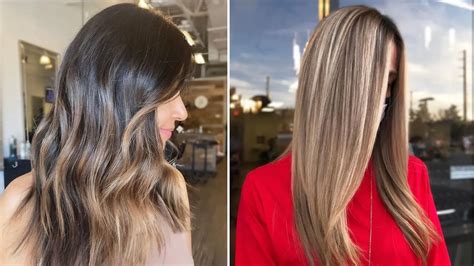Introduction
When it comes to hair dyeing, two techniques often come to mind: balayage and highlights. While both methods can give you beautiful, sun-kissed strands, there are some key differences between the two. In this comprehensive guide, we will explore the pros and cons of each technique, help you choose the right one for your hair, and provide tips for getting the best results.

What is Balayage?
Balayage is a French word that means “to sweep.” It is a freehand hair-painting technique that involves applying bleach or hair color to the hair in a sweeping motion. This creates a soft, natural-looking gradient of color that is typically lighter at the ends and darker at the roots.
What are Highlights?
Highlights are a more traditional hair-dyeing technique that involves separating small sections of hair and applying bleach or hair color to them individually. This creates a more defined, brighter look that is often used to add contrast to the hair.
Balayage vs. Highlights: Key Differences
To help you better understand the differences between balayage and highlights, here is a table summarizing the key differences:
| Feature | Balayage | Highlights |
|---|---|---|
| Application method | Freehand | Individual sections |
| Result | Soft, natural-looking gradient | Defined, brighter contrast |
| Maintenance | Less frequent (every 3-6 months) | More frequent (every 6-8 weeks) |
| Cost | Typically more expensive | Typically less expensive |
Pros and Cons of Balayage
Pros:
- Creates a soft, natural-looking gradient of color
- Can be customized to suit your hair color and style
- Less damaging to the hair than highlights
- Less frequent maintenance required
Cons:
- Can be more expensive than highlights
- Can take longer to apply
- May not be suitable for all hair types or colors
Pros and Cons of Highlights
Pros:
- Creates a more defined, brighter look
- Can be used to add contrast to the hair
- Less expensive than balayage
- Can be applied more quickly
Cons:
- Can be more damaging to the hair than balayage
- More frequent maintenance required
- May not be suitable for all hair types or colors
Which Technique is Right for You?
The best hair-dyeing technique for you will depend on your individual hair type, color, and style goals. If you are looking for a natural-looking gradient of color that is low-maintenance, balayage may be the better option. If you want a more defined, brighter look, highlights may be the better choice.
Choosing the Right Salon
When choosing a salon to get your balayage or highlights done, it is important to do your research. Look for a salon that has experienced stylists who are knowledgeable about the latest hair-dyeing techniques. Be sure to ask about their experience with balayage and highlights, and look at their portfolio to see examples of their work.
Tips for Getting the Best Results
Here are a few tips for getting the best results from your balayage or highlights:
- Bring in a photo of the look you want to achieve.
- Communicate your hair goals to your stylist clearly.
- Be patient, as the process can take several hours.
- Follow your stylist’s instructions for aftercare carefully.
Common Mistakes to Avoid
Here are a few common mistakes to avoid when getting balayage or highlights:
- Going too blonde too quickly.
- Using the wrong color for your hair type and skin tone.
- Over-processing the hair.
- Not following your stylist’s aftercare instructions.
FAQs
1. How much does balayage cost?
The cost of balayage can vary depending on the salon, the length of your hair, and the complexity of the look you want to achieve. However, you can expect to pay anywhere from $100 to $500 for a full balayage.
2. How long does balayage last?
Balayage can last for several months, depending on how quickly your hair grows. However, you may need to get your roots touched up every 3-6 months to maintain the look.
3. Is balayage damaging to hair?
Balayage is less damaging to hair than highlights, as it does not require as much bleach or processing time. However, it is still important to follow your stylist’s aftercare instructions carefully to minimize any damage.
4. Can I do balayage at home?
It is not recommended to attempt balayage at home, as it is a complex technique that requires experience and skill. It is best to leave it to a professional stylist to ensure the best results.
5. What is the difference between balayage and ombré?
Ombré is a hair-dyeing technique that creates a gradual transition from one color to another. Balayage is a more natural-looking technique that creates a soft, blended gradient of color.
6. What is the difference between balayage and babylights?
Babylights are a type of highlight that is very thin and subtle. They are often used to create a natural-looking, sun-kissed effect. Balayage is a more freehand technique that creates a more blended gradient of color.
7. What are the latest trends in balayage?
Some of the latest trends in balayage include:
- Root smudging: Blending the roots in a darker color to create a more natural look
- Reverse balayage: Lightening the roots and darkening the ends to create a more dramatic look
- Foilayage: Combining balayage with foiling to create more defined highlights
- Hair painting: Using a brush to apply bleach or hair color directly to the hair, creating a highly customized look
Conclusion
Balayage and highlights are two of the most popular hair-dyeing techniques today. While both techniques can give you beautiful, sun-kissed strands, there are some key differences between the two. By understanding the differences between balayage and highlights, you can choose the right technique for your hair and achieve the look you desire.
